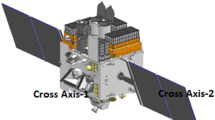Abstract
Selecting orbits for a satellite to observe the Earth is a very important task in aerospace engineering. There are several constraints to be followed, like regions of the Earth to be observed, interval between observations, the necessity or not of having sunlight to make the observations, etc. In this study, we search for orbits that can be used to collect data from platforms located around the Earth and send them to particular ground stations. Since we are considering that these missions will be performed in the extra life of old satellites, it is necessary to add the constraint of having sunlight during the communications, because the old batteries will no longer be able to keep charge. So, we need to find the best orbits for a mission of this type, such that we can consider this possibility as one more parameter to design the orbits of satellites to be launched, and/or to choose the most adequate satellites that are already in space to accomplish this task. To carry out this study, we considered different latitudes for the platforms and ground stations. The satellites are assumed to be in Low Earth Orbit (LEO) with different inclinations.














Similar content being viewed by others
Data availability
The data underlying this article will be shared on reasonable request to the corresponding author.
References
C.D. Murray, S.F. Dermott, Solar system dynamics by C.D. Murray and S.F. McDermott. (Cambridge, UK: Cambridge University Press), ISBN 0-521-57295-9 (hc.), ISBN 0-521-57297-4 (pbk.) (1999)
S.T. Thornton, J.B. Marion, Classical Dynamics of Particles and Systems., by Thornton, S. T. and Marion, J. B. USA: Brooks/Cole, 656 p (2004)
F.R. Moulton, An introduction to celestial mechanics., by Moulton, F. R. New York, NY (USA): Dover Publications, 436 p (1972)
L.B.T. Santos, P.A. Sousa-Silva, M.O. Terra et al., Adv. Space Res. 70, 3362 (2022). https://doi.org/10.1016/j.asr.2022.08.035
A. Poghosyan, A. Golkar, Prog. Aerosp. Sci. 88, 59 (2017). https://doi.org/10.1016/j.paerosci.2016.11.002
G. Beutler, Methods of celestial mechanics. Vol. I / Gerhard Beutler. In cooperation with Leos Mervart and Andreas Verdun. Astronomy and Astrophysics Library. Berlin: Springer, ISBN 3-540-40749-9, 2005, XVI, 464 pp. 99 figures, 11 in color, 32 tables and a CD-ROM., 99 (2005)
D.A. Vallado, Fundamentals of astrodynamics and applications (Springer, Berlin, 2007). (ISBN: 978-0-387-71831-6)
H. Goldstein, C. Poole, J. Safko, Classical mechanics, 3rd edn. (Addison-Wesley, San Francisco, 2002)
A.E. Roy, Orbital motion / A. E. Roy. Bristol (UK): Institute of Physics Publishing, 4th edition. ISBN 0-7503-1015-6, 2005, XVIII + 526 pp (2005)
J.R. Wertz, Mission geometry: orbit and constellation design and management: spacecraft orbit and attitude systems/ James R. Wertz. El Segundo, CA; Boston: Microcosm: Kluwer Academic Publishers, 2001. Space technology library; 13 (2001)
T. Yokoyama, Planet. Space Sci. 50, 63 (2002). https://doi.org/10.1016/S0032-0633(01)00078-2
O. Montenbruck, E. Gill, F. Lutze, Appl. Mech. Rev. 55, B27 (2002). https://doi.org/10.1115/1.1451162
G. Beutler, Methods of celestial mechanics. Vol. II / Gerhard Beutler. In cooperation with Leos Mervart and Andreas Verdun. Astronomy and Astrophysics Library. Berlin: Springer, ISBN 3-540-40750-2, 2005, XVI, 464 pp. 266 figures, 14 in color, 28 tables and a CD-ROM., 266 (2005)
L.B.T. dos Santos, A.F.B. de Almeida Prado, D.M. Sanchez, Astrophys. Space Sci. 362, 202 (2017). https://doi.org/10.1007/s10509-017-3177-x
L.B.T. Santos, L.O. Marchi, S. Aljbaae et al., Mon. Not. R. Astron. Soc. 502, 4277 (2021). https://doi.org/10.1093/mnras/stab198
L.B.T. Santos, P.A. Sousa-Silva, M.O. Terra et al., Planet. Space Sci. 233, 105701 (2023). https://doi.org/10.1016/j.pss.2023.105701
Acknowledgements
The authors wish to express their appreciation for the support provided by: grant 304741/2020-5, 309089/2021-2, 400077/2022-1 and 301058/2022-9 from the National Council for Scientific and Technological Development (CNPq); grants IBPG-1083\(-\)3.03/20 from the Foundation for the Support of Science and Technology of Pernambuco (FACEPE); the Coordination for the Improvement of Higher Education Personnel (CAPES) and from the National Institute for Space Research (INPE). This publication has been supported by the RUDN University Scientific Projects Grant System, project No 202235-2-000. The authors are grateful for the financial support of the Brazilian Agencies FACEPE, CAPES, FINEP, and CNPq. NB Lima also thank L’Oréal-UNESCO-ABC “For Women in Science”. NBL, and TFAS thank CNPq for the scientific productivity scholarship.
Author information
Authors and Affiliations
Corresponding author
Rights and permissions
Springer Nature or its licensor (e.g. a society or other partner) holds exclusive rights to this article under a publishing agreement with the author(s) or other rightsholder(s); author self-archiving of the accepted manuscript version of this article is solely governed by the terms of such publishing agreement and applicable law.
About this article
Cite this article
Santos, L.B.T., Prado, A.F.B.A., Santos, T.F.A. et al. Selecting orbits for Earth observations. Eur. Phys. J. Spec. Top. 232, 3037–3047 (2023). https://doi.org/10.1140/epjs/s11734-023-01030-0
Received:
Accepted:
Published:
Issue Date:
DOI: https://doi.org/10.1140/epjs/s11734-023-01030-0




